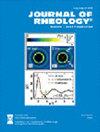Rheo-electric measurements of carbon black suspensions containing polyvinylidene difluoride in N-methyl-2-pyrrolidone
IF 3.2
2区 工程技术
Q2 MECHANICS
引用次数: 1
Abstract
Lithium-ion battery cathode slurries have a microstructure that depends sensitively on how they are processed due to carbon black's (CB) evolving structure when subjected coating flows. While polyvinylidene difluoride (PVDF), one of the main components of the cathode slurry, plays an important role in modifying the structure and rheology of CB, a quantitative understanding is lacking. In this work, we explore the role of PVDF in determining the structural evolution of Super C65 CB in N-methyl-2-pyrrolidinone (NMP) with rheo-electric measurements. We find that PVDF enhances the viscosity of NMP resulting in a more extensive structural erosion of CB agglomerates with increasing polymer concentration and molecular weight. We also show that the relative viscosity of all suspensions can be collapsed by the fluid Mason number [Formula: see text], which compares the hydrodynamic forces imposed by the medium to cohesive forces holding CB agglomerates together. Using simultaneous rheo-electric measurements, we find at high [Formula: see text], the dielectric strength [Formula: see text] scales with [Formula: see text], and the power-law scaling can be quantitatively predicted by considering the self-similar break up of CB agglomerates. The collapse of the relative viscosity and scaling of [Formula: see text] both suggest that PVDF increases the hydrodynamic force of the suspending medium without directly changing the CB agglomerate structure. These findings are valuable for optimizing the rheology of lithium ion battery cathode slurries. We also anticipate that these findings can be extended to understand the microstructure of similar systems under flow.在n -甲基-2-吡咯烷酮中含有聚偏二氟乙烯的炭黑悬浮液的流变电测量
锂离子电池阴极浆料的微观结构敏感地取决于它们的加工方式,这是由于在涂层流动时炭黑(CB)的演变结构。虽然聚偏二氟乙烯(PVDF)是阴极浆料的主要成分之一,在改变CB的结构和流变性方面发挥着重要作用,但缺乏定量的理解。在这项工作中,我们探索了PVDF在通过流变电测量确定N-甲基-2-吡咯烷酮(NMP)中Super C65 CB的结构演变中的作用。我们发现,随着聚合物浓度和分子量的增加,PVDF提高了NMP的粘度,导致CB团聚体的结构受到更广泛的侵蚀。我们还表明,所有悬浮液的相对粘度都可以通过流体梅森数[公式:见正文]来降低,梅森数将介质施加的流体动力与将CB团聚体保持在一起的内聚力进行了比较。使用同时的流变电测量,我们发现在高[公式:见正文]下,介电强度[公式:参见正文]与[公式:详见正文]成比例,并且可以通过考虑CB团聚体的自相似破裂来定量预测幂律成比例。相对粘度的崩溃和[公式:见正文]的结垢都表明PVDF在不直接改变CB团聚体结构的情况下增加了悬浮介质的流体动力。这些发现对优化锂离子电池阴极浆料的流变性有价值。我们还预计,这些发现可以扩展到理解流动下类似系统的微观结构。
本文章由计算机程序翻译,如有差异,请以英文原文为准。
求助全文
约1分钟内获得全文
求助全文
来源期刊

Journal of Rheology
物理-力学
CiteScore
6.60
自引率
12.10%
发文量
100
审稿时长
1 months
期刊介绍:
The Journal of Rheology, formerly the Transactions of The Society of Rheology, is published six times per year by The Society of Rheology, a member society of the American Institute of Physics, through AIP Publishing. It provides in-depth interdisciplinary coverage of theoretical and experimental issues drawn from industry and academia. The Journal of Rheology is published for professionals and students in chemistry, physics, engineering, material science, and mathematics.
 求助内容:
求助内容: 应助结果提醒方式:
应助结果提醒方式:


